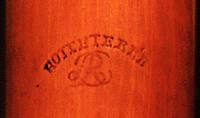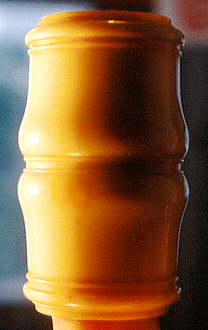| |
Update to my article, 'The Hotteterre Flute: Six Replicas in
Search of a Myth',Journal of the American Musicological
Society XLIX (1996), 225-63
by Ardal Powell
A RECENTLY-DISCOVERED flute can be added to the small
tally of genuine early eighteenth-century woodwinds
by members of the Hotteterre family. It had not yet
come to light when I wrote my 1996 JAMS article
on the Hotteterre flute or the Jacques
Martin Hotteterre "le Romain" (1674-1763) page ,
but this page describes the instrument and compares
it with the flutes I discussed in that essay.
The flute is in boxwood and ivory,
and is stamped with a hitherto unrecorded maker's mark, which includes
a monogram of the letters LR. All the other "Hotteterre"
flutes I studied are either stamped HOTTETERRE/anchor
or are unmarked. There is no definite indication at present of what
the LR monogram might signify, though it seems possible that it
stands for "Le Romain". However I suppose this interpretation
would require the slightly far-fetched assumption that Jacques Hotteterre
started a new workshop of his own rather than retaining the trademark
of his father, Martin.
 |
The newly-discovered Hotteterre flute.
|
 |
The
flute's stamp, a previously unrecorded form, contains
a monogram of the letters "LR". |
___Although
it unfortunately lacks its foot-joint, I am convinced
the instrument is unaltered in all other respects. [Note:
I am not convinced of this any more: I think the headjoint
has been shortened slightly, to raise the pitch, where
it fits into the ivory connector.] It has moderate wear
from use, including some bore shrinkage (see graph
below), but its general condition is good enough that
tool marks from manufacture are still in evidence. Its
tenon ends, like those of G and S, are not faced flat
but slanted outward, and like G its embouchure walls have
some scraper marks. The center joint is quite noticeably
warped: this is unusual enough in an original 3-joint
flute that in my JAMS essay (p. 257) I found
the warping of Bn and P471 to weigh against their authenticity.
However the LR flute shows other signs besides the scraper
marks that it was not made by the most careful of hands,
including tool chatter in the sockets and tearing of the
grain on the lowest tenon.
___Using a non-original footjoint,
I played it at a pitch of about a=402, which is closer
to S (about a=400) than G (about a=392). [I think the
original pitch before shortening was closer to 392 though.]
 |
Tool
marks in the embouchure seem to be from manufacture, not later
alteration. |
 |
The
ivory turning of the connector between head and middle joints
is in the typical "Hotteterre" style (JAMS
article, footnote 4). |
Measurements
___Comparing
the flute with the two other genuine Hotteterre-type flutes (G and
S) shows that the main design differences are in the lower part
of the center joint. Below is a revised version of Table 2 of my
essay, now including data from the LR flute (on the line highlighted
in yellow). This indicates the positions of toneholes 4, 5, and
6 (columns e, f, g) to be much higher on the tube than those of
the other two flutes. The effect is easier to see in the bottom
line of the table where the differences between maxima and minima
for these values appear as numbers in red. Note also the similarity
between average measurements for the "Group A" flutes (i.e. those
based on X', the original I supposed lost from La Couture) and the
LR flute. This means that, in a rough comparison of design, LR is
more similar to X' than to G or S.
| Abbr. |
Location |
a |
b |
c |
d |
e |
f |
g |
h |
i |
j |
k |
l |
| Measured values |
|
|
|
|
|
|
|
|
|
|
|
|
|
| Bn |
Berlin 2670 |
128.25 |
42.33 |
81.60 |
120.55 |
184.25 |
223.00 |
260.60 |
88.95 |
159.50 |
280.20 |
102.10 |
72.90 |
| M |
Miller 428 |
127.25 |
42.70 |
81.35 |
120.33 |
185.30 |
223.90 |
261.55 |
90.80 |
159.50 |
281.09 |
102.30 |
72.65 |
| Br |
Brussels 3131 |
127.85 |
42.75 |
81.75 |
120.40 |
185.65 |
224.35 |
261.55 |
90.12 |
159.07 |
281.59 |
102.45 |
73.00 |
| P471 |
St Petersburg 471 |
128.60 |
42.60 |
81.80 |
120.60 |
185.70 |
224.70 |
262.30 |
88.65 |
160.80 |
281.60 |
101.86 |
73.58 |
| C |
La Couture |
127.30 |
42.60 |
81.60 |
120.35 |
185.60 |
224.17 |
261.55 |
89.02 |
160.55 |
280.95 |
101.95 |
73.04 |
| P472 |
St Petersburg 472 |
128.10 |
42.85 |
82.00 |
120.90 |
185.90 |
224.45 |
262.20 |
89.39 |
161.14 |
281.10 |
102.13 |
71.90 |
| LR |
Paris,
Musée de la musique |
128.17 |
44.15 |
82.90 |
124.08 |
182.65 |
222.36 |
260.54 |
26.42 |
171.14 |
281.84 |
N/A |
64.98 |
| S |
Stuttgart |
131.20 |
44.00 |
83.75 |
122.40 |
187.15 |
227.30 |
264.25 |
39.60 |
158.80 |
282.30 |
99.20 |
65.90 |
| G |
Graz 1384 |
137.00 |
49.00 |
87.00 |
127.00 |
191.00 |
229.50 |
266.00 |
57.20 |
166.50 |
284.00 |
110.80 |
65.90 |
| |
|
|
|
|
|
|
|
|
|
|
|
|
|
| Calculated values |
|
|
|
|
|
|
|
|
|
|
|
|
|
| |
X (Avg. Group A) |
127.89 |
42.64 |
81.68 |
120.52 |
185.40 |
224.10 |
261.63 |
89.49 |
160.09 |
281.09 |
102.13 |
72.85 |
| |
Range, Group A |
1.35 |
0.52 |
0.65 |
0.57 |
1.65 |
1.70 |
1.70 |
2.15 |
2.07 |
1.40 |
0.59 |
1.68 |
| |
Range of G, S, X |
9.11 |
6.36 |
5.32 |
6.48 |
5.60 |
5.40 |
4.38 |
49.89 |
7.70 |
2.91 |
11.60 |
6.95 |
| |
Range of G, S, X,
LR |
9.11 |
6.36 |
5.32 |
6.48 |
8.35 |
7.14 |
5.46 |
63.07 |
12.34 |
2.91 |
11.60 |
7.87 |
Note:
Total sounding length, from the embouchure center
to the end, is a + j + k + l. Group A, shown in the
light brown color, comprises Bn, M, Br, P471, C, and
P472.
| a |
Embouchure center,
measured from the lower headjoint tenon shoulder |
| b |
Center of tonehole 1, measured
from center joint top tenon shoulder |
| c |
Center of tonehole 2, measured
from center joint top tenon shoulder |
| d |
Center of tonehole 3, measured
from center joint top tenon shoulder |
| e |
Center of tonehole 4, measured
from center joint top tenon shoulder |
| f |
Center of tonehole 5, measured
from center joint top tenon shoulder |
| g |
Center of tonehole 6, measured
from center joint top tenon shoulder |
| h |
Total length of cap |
| i |
Length of head, excluding tenons |
| j |
Sounding length (total length excluding
tenons) of center joint |
| k |
Total length of footjoint |
| l |
Total length of connector between
head and center joints |
|
___The
flute's bore is shown by the green trace on the graph below,
alongside the bore of G in blue, that of Bn in purple, and that
of S in red. The trace of LR shows some not unexpected shrinkage
in the region of the top tenon, from c. 190-260 on the horizontal
scale. Otherwise its most notable differences are, once again,
in the lower half of the middle joint.
___I find more overall similarity
of design between LR and S than between LR and G. I think the
LR flute's parallels with S make it seem more likely that S,
which is not signed, is the work of someone in the Hotteterre
circles.
___Since LR's footjoint is missing,
it is necessary to devise one with a suitable length and bore
to supply the lack. In experiments in the Folkers
& Powell workshop we found the footjoint of Bn to be more
suitable than that of G or S.
|
Click here to view the bore
graph in a separate window
|